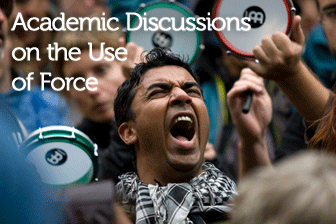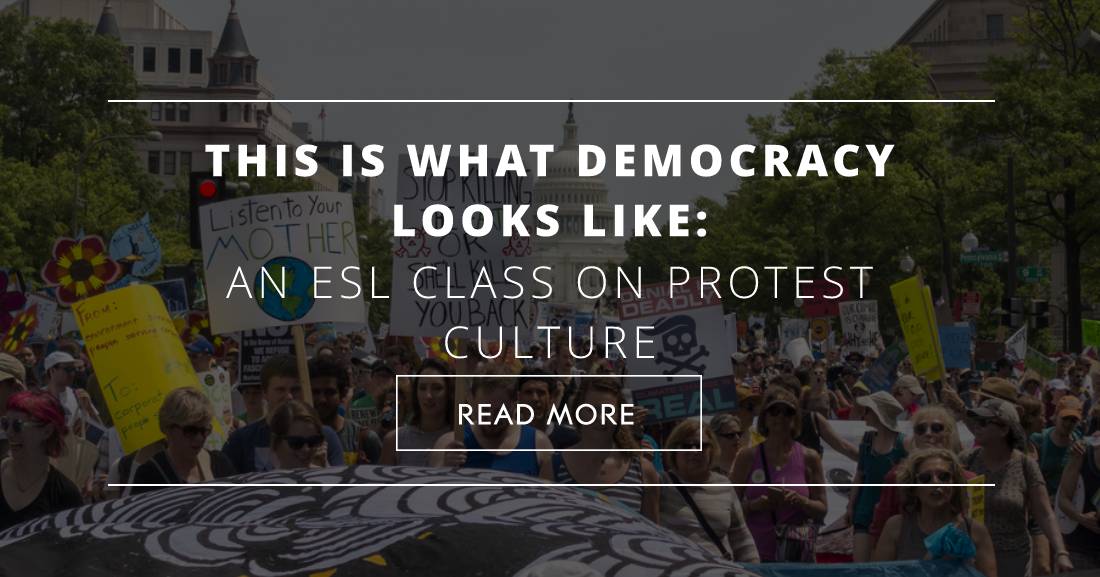From “Shooting an Elephant” to the Occupy Movement: Academic Discussions on the Use of Force


After greeting my class one Friday morning, I wrote on the board, in large letters: What are you angry about?
My current class is a young, advanced group from a mix of backgrounds, and many of them have fully-formed political views. I rely on this, in many ways, to support our discussions of complex, contemporary topics, but I also recognized I’d be opening a can of words with my initial question.
Three minutes later, we’d brainstormed a list of thirty events, strands of thoughts and policies which made at least one of my students angry. The next question was an obvious one: OK, so what are you doing about it?
Some were giving to charity, helping with letter-writing campaigns, or taking part on social media. But most of my students felt that they weren’t in a position to bring about political change, either in the US or in their own countries. I wanted to know more about this, so I set up a quick interview in pairs, allowing the students to compose their own questions. The aim was to learn about protest movements around the world, and to establish a baseline of vocabulary and structures. Some of the best questions were:
Once more, I was faced with the problem that my students from China and Saudi Arabia (in particular) were obliged to defend their government’s response to organized opposition. I always remind my students (and the BusyTeacher readership) that government and citizenry are not synonyms, and that under the surface, there is often a huge tide of impatient resentment. Disagreeing with your government is not an act of unpatriotic disloyalty, I argued, because no leader should consider themselves above being debated. Besides, many of the most troubling policies (imprisoning protesters, removing rights of privacy and representation, banning assemblies or political groups) run counter to the country’s constitution.
We took a step back to brainstorm the most common topics of a protest. A useful way of discovering these themes was to look at photos from recent marches in the United States, where there has been an unprecedented diversity of issues. The protest signs clued us in:
Within each of these categories, we found pictorial or written evidence of sub-categories which are too numerous to list. Some signs were very particular to a given place and time (the Standing Rock protests in North Dakota), while others attacked long-running issues which permeate US politics (e.g. campaign finance, corruption and inequality).
I posed the question: If you could march this weekend to raise awareness of a single issue, what would it be? In pairs, my students mulled this over, and then provided interesting feedback.
Climate change was at the very top of the list, followed by the US plan to ban migrants from seven (and subsequently six) Muslim-majority countries; the architect of this proposal, Trump advisor and hard-right figure Steve Bannon, came in for strong, personal criticism. Then came the US intervention in Syria (at the time of writing, President Trump has carried out a single, highly controversial missile strike) and the potential for conflict on the Korean peninsula.
If necessary, introduce your students to a city which has seen major protests in the past (London’s Trafalgar Square, New York’s Times Square, San Francisco’s Market Street, Boston’s Commonwealth Avenue) and invite them to consider how this space might be used for a massive, unprecedented protest on a single issue. I divided my students into three groups, each with an issue and a city of their own, and asked them to lay the initial groundwork:
Once each group had a basic map of their plan, we began focusing on how to reach as many people as possible. Brainstorming quickly, my students found that social media was an essential method, but not nearly the only one; use of radio advertising, podcasts, celebrity endorsements, mentions of the march on late night shows such as the Daily Show, and even support from elected officials were all discussed.
Then, we got really creative. Each team was asked to compose signs and chants for their march. There were so many online examples that we were spoiled for choice, and almost by necessity, many of these were somewhat derivative. However, I absolutely love it when my students combine creativity and language learning, and this group really hit one out of the park:
| Climate Change: | We Haven’t Found Earth Two Yet Make America Green Again |
| The 2016 Election: | Ikea Makes Better Cabinets Than This Hail To The Thief This Should Never Feel Normal |
| Women’s Rights: | Careful! I Fight Like a Girl! This Is A Public Cervix Announcement Is Nothing Without Hermione |
| Migrants’ Rights: | The Mayflower Folks were Undocumented Too |
To spare blushes, I’ve had to omit some of my favorites; while evincing sharp wit and a lively awareness of language, they crossed some lines. I’m sure you know the kind of thing I mean.
There are great opportunities for written work based on a real or fictional protest. Blog entries, newspaper reports, personal journals and letters to family are all possible. I love creating TV shows from exercises like this, where an anchor interviews experts, politicians, media personalities, protestors, activists or professors. By far the funniest of these was a star turn by a Chilean student of mine who conjured a Donald Trump impression to rival that of Alex Baldwin; his ‘Trump’ participated in a side-splitting debate with an activist for women’s rights (who stayed in character, refusing to see the funny side) and a Republican strategist who spent the whole debate trying to keep his boss on topic. Honestly, I nearly died laughing.
Seriously, though, if your students have the chance to attend a real protest, or perhaps to speak to activists or community organizers, these would be priceless learning opportunities. I encouraged my students to participate in street protests – and to be careful, of course – while challenging their viewpoints when they strayed from a factual grounding. We agreed that protestors should be engaging and funny, but that their message shouldn’t be drowned out by protest-voyeurism, or by basic mistakes over facts.
We can predict that issues will continually crop up, and that old themes will stick around to frustrate those searching for change. By allowing my students to connect with these issues, and to be creative in their approach, we practiced lots of useful language while summing up some of the big themes of modern political debate. Protesting is a right, and arguably also a responsibility, and so I recommend that you try a class on this topic with your students, and see just how creative they can be.